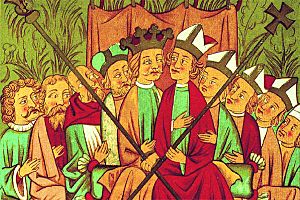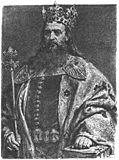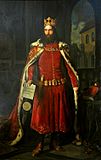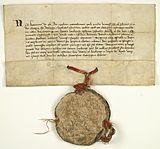Casimir III the Great facts for kids
Quick facts for kids Casimir III the Great |
|
|---|---|
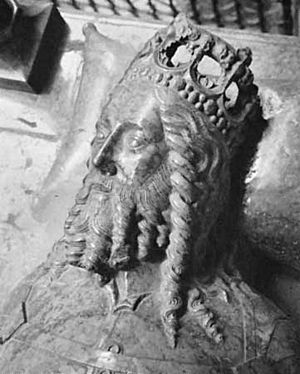
Casimir's tomb effigy in Wawel
|
|
| King of Poland | |
| Reign | 1333–1370 |
| Coronation | 25 April 1333 |
| Predecessor | Ladislaus the Short |
| Successor | Louis I of Hungary |
| King of Ruthenia | |
| Reign | 1340–1370 |
| Predecessor | Yuri II of Galicia |
| Successor | Louis I of Hungary |
| Born | 30 April 1310 Kowal, Duchy of Brześć Kujawski |
| Died | 5 November 1370 (aged 60) Kraków, Poland |
| Burial | Wawel Cathedral, Kraków |
| Spouse | Aldona of Lithuania Adelaide of Hesse Christina Rokiczana Hedwig of Sagan |
| Issue more... |
Elisabeth, Duchess of Pomerania Anna, Countess of Cilli |
| House | Piast |
| Father | Władysław I Łokietek |
| Mother | Jadwiga of Kalisz |
| Religion | Roman Catholic |
| Signature | 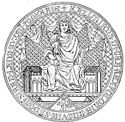 |
Casimir III the Great (Polish: Kazimierz III Wielki) was the King of Poland from 1333 to 1370. He was born on April 30, 1310, and passed away on November 5, 1370. He also became the King of Ruthenia in 1340. Casimir was the very last Polish king from the Piast dynasty, a very old royal family.
When Casimir became king, Poland was weak from wars. But he worked hard to make it strong and rich again. He improved the army and made the country twice as big! He also changed the legal system and created new laws. Because of this, people called him "the Polish Justinian", after a famous Roman emperor who made many laws.
Casimir built many new things, like castles and towns. He also started the Jagiellonian University in Kraków. It is the oldest university in Poland and one of the oldest in the world! He also made sure that Jewish people had special rights and protection, encouraging many to live in Poland.
Casimir did not have any sons who could take over the throne. When he died in 1370 after a hunting accident, his nephew, King Louis I of Hungary, became the next King of Poland. This meant that Poland and Hungary were ruled by the same person for a while.
Contents
Casimir: The Great King of Poland
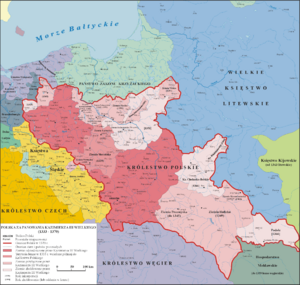
Casimir was born on April 30, 1310, in Kowal. He was the third son of King Ladislaus the Short and Jadwiga of Kalisz. He had two brothers who died very young and three sisters. When Casimir became king in 1333, his position was not easy. Some neighboring countries did not fully recognize him as king of all Poland. They only called him "king of Kraków".
Poland was also very tired from wars, and its economy was struggling. In 1335, Casimir had to give up his claims to a region called Silesia forever.
Casimir quickly started to rebuild the country and make it safer. During his time as king, almost 30 towns got strong walls for defense. About 50 castles were also built, including many along the famous Trail of the Eagle's Nests. People still remember his building efforts today with a popular saying: "Casimir the Great found Poland made of wood and left it made of stone and brick."
In 1364, Casimir hosted a big meeting of kings in Kraków. He showed off how wealthy and strong the Polish kingdom had become. Casimir is the only Polish king in history who is still known as "the Great."
Making Poland Stronger: Reforms
Casimir made sure Poland would be stable and have a bright future. He created the "Crown of the Polish Kingdom" (Corona Regni Poloniae). This meant that Poland was a country that existed on its own, not just as the king's personal property. Before this, the lands were seen as belonging only to the Piast dynasty.
In 1347, Casimir changed the Polish legal system. He introduced new laws for both civil (everyday life) and criminal matters. This earned him the nickname "the Polish Justinian." In 1364, with permission from the Pope, Casimir founded the University of Kraków. It was only the second university in Central Europe, which was a big achievement.
Expanding the Kingdom: Politics and Growth
Casimir was very good at dealing with other countries. He managed to make his kingdom twice as large! He made peace with potential enemies in the west and north. Then, he started to expand Poland's territory towards the east.
He conquered the Ruthenian kingdom of Halych and Volodymyr, which is now part of Ukraine. This area was known as Red Ruthenia and Volhynia. By extending Poland's borders far to the southeast, the kingdom gained access to important trade routes on the Black Sea. This helped Poland become even richer.
Who Would Rule Next? Succession
In 1355, Casimir made an agreement in Buda. He named his nephew, Louis I of Hungary, as his successor if he did not have a son. Casimir was 45 years old at the time, so he still hoped to have a son. In return for this agreement, Hungary became a friendly ally. This was important for Casimir in his disagreements with the powerful Teutonic Order and the Kingdom of Bohemia.
However, Casimir never had a son. He had five daughters instead. In his last will, he tried to adopt his grandson, Casimir IV, Duke of Pomerania. This boy was the son of his eldest daughter, Elisabeth. But after Casimir died in 1370, Louis I of Hungary quickly came to Kraków. He convinced the Polish nobles to ignore Casimir's will by promising them special rights in the future.
So, King Louis I of Hungary became the next ruler of Poland. Louis was declared king when Casimir died in 1370. Casimir's sister Elisabeth, who was Louis's mother, held a lot of power in Poland until she passed away in 1380.
Life in Poland Under Casimir
Casimir was sometimes playfully called "the Peasants' King." He introduced new laws for both Greater and Lesser Poland. These laws tried to reduce the power of the rich nobles. During his rule, the three main groups in society – the nobles, the church leaders, and the townspeople – had a more balanced power. This helped Casimir strengthen his own position as king.
He was known for helping ordinary people when the law did not protect them from powerful nobles or church members. He even reportedly supported a peasant whose house was destroyed by a rich woman. She had ordered it pulled down because it blocked her view of the beautiful countryside!
His popularity with the peasants also helped rebuild the country. A special land tax paid by the lower class helped fund many of his reconstruction projects.
Casimir and the Jewish Community
On October 9, 1334, Casimir confirmed special rights for Jewish people that had been given to them earlier. He made it illegal to kidnap Jewish children to force them to become Christian. He also put in place strong punishments for damaging Jewish cemeteries.
Jewish people had lived in Poland before Casimir's time. But Casimir allowed many more to settle in Poland and protected them as "people of the king." Because of Casimir's policies, about 70 percent of the world's European Jews, called Ashkenazi, can trace their family history back to Poland. There is a famous story about Casimir having a Jewish companion named Esterka, but historians are not sure if this story is true.
Casimir's Family and Children
King Casimir III was married four times.
Aldona of Lithuania
On April 30 or October 16, 1325, Casimir married Aldona of Lithuania. She was the daughter of Grand Duke Gediminas of Lithuania. They had two daughters:
- Elisabeth of Poland (born around 1326, died 1361); she married Duke Bogislaus V of Pomerania.
- Cunigunde of Poland (born 1334, died 1357); she married Louis VI the Roman.
Aldona died on May 26, 1339. Casimir remained unmarried for two years after her death.
Adelaide of Hesse
On September 29, 1341, Casimir married his second wife, Adelaide of Hesse. She was the daughter of Henry II, Landgrave of Hesse. They did not have any children. Casimir and Adelaide started living apart soon after their wedding. This marriage was not happy and lasted until 1356, when Casimir said he was divorced.
Christina Rokiczana
After Casimir said he was divorced from Adelaide, he married his close companion, Christina Rokiczana. She was a wealthy merchant's widow. Casimir brought her from Prague and arranged for a secret wedding. The marriage soon became known. Queen Adelaide said it was not legal because she was still alive. Casimir continued to live with Christina despite complaints from the Pope. This marriage lasted until 1363 or 1364, when Casimir again said he was divorced. They did not have any children.
Hedwig of Żagań
Around 1365, Casimir married his fourth wife, Hedwig of Żagań. She was the daughter of Henry V of Iron, Duke of Żagań. They had three children:
- Anna of Poland, Countess of Celje (born 1366, died June 9, 1422); she first married William of Celje. Their daughter, Anne of Celje, later married Jogaila of Lithuania when he was King of Poland. Anna then married Ulrich, Duke of Teck, but they had no children.
- Kunigunde of Poland (born 1367, died 1370).
- Jadwiga of Poland (born 1368, died around 1382).
Because Adelaide was still alive (and possibly Christina too), Casimir's marriage to Hedwig was also seen as not fully legal by some. This meant that the legitimacy of his three young daughters was questioned. Casimir worked to have Anna and Kunigunde declared legitimate by Pope Urban V in 1369. His youngest daughter, Jadwiga, was declared legitimate by Pope Gregory XI in 1371, after Casimir had passed away.
Casimir in Popular Culture
Film
- Casimir III the Great is a main character in the Polish historical TV series Korona królów (The Crown of the Kings).
- He is mentioned in a speech in the film Schindler's List.
Video Games
- Casimir appears as a leader you can play in the strategy game Civilization V.
- He is also a ruler in the strategy game Crusader Kings II.
Currency
- Casimir's picture is on the front of the 50 Polish złoty banknote. His royal symbols are on the back.
Gallery
-
Casimir III the Great by Jan Matejko
-
A document from Casimir the Great, allowing the Armenian bishop Gregory to live and preach in Lviv, 1367.
See also
 In Spanish: Casimiro III de Polonia para niños
In Spanish: Casimiro III de Polonia para niños
- History of Poland (966–1385)
- Jagiellonian University
- Congress of Kraków
- Kazimierz
- Kazimierz Dolny
- List of Poles
- Esterka


